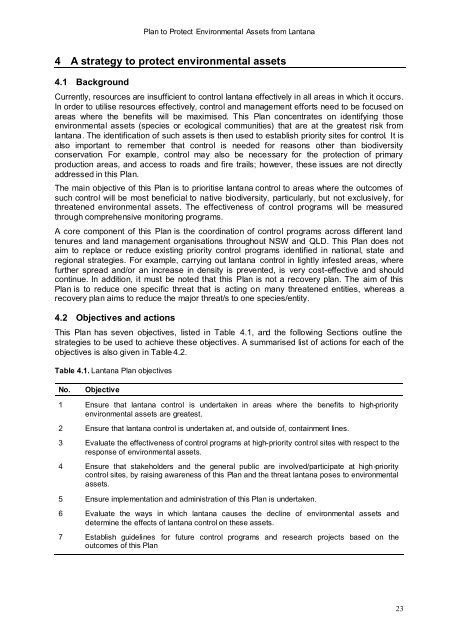Plan to Protect Environmental Assets from Lantana - Weeds Australia
Plan to Protect Environmental Assets from Lantana - Weeds Australia
Plan to Protect Environmental Assets from Lantana - Weeds Australia
You also want an ePaper? Increase the reach of your titles
YUMPU automatically turns print PDFs into web optimized ePapers that Google loves.
<strong>Plan</strong> <strong>to</strong> <strong>Protect</strong> <strong>Environmental</strong> <strong>Assets</strong> <strong>from</strong> <strong>Lantana</strong><br />
4 A strategy <strong>to</strong> protect environmental assets<br />
4.1 Background<br />
Currently, resources are insufficient <strong>to</strong> control lantana effectively in all areas in which it occurs.<br />
In order <strong>to</strong> utilise resources effectively, control and management efforts need <strong>to</strong> be focused on<br />
areas where the benefits will be maximised. This <strong>Plan</strong> concentrates on identifying those<br />
environmental assets (species or ecological communities) that are at the greatest risk <strong>from</strong><br />
lantana. The identification of such assets is then used <strong>to</strong> establish priority sites for control. It is<br />
also important <strong>to</strong> remember that control is needed for reasons other than biodiversity<br />
conservation. For example, control may also be necessary for the protection of primary<br />
production areas, and access <strong>to</strong> roads and fire trails; however, these issues are not directly<br />
addressed in this <strong>Plan</strong>.<br />
The main objective of this <strong>Plan</strong> is <strong>to</strong> prioritise lantana control <strong>to</strong> areas where the outcomes of<br />
such control will be most beneficial <strong>to</strong> native biodiversity, particularly, but not exclusively, for<br />
threatened environmental assets. The effectiveness of control programs will be measured<br />
through comprehensive moni<strong>to</strong>ring programs.<br />
A core component of this <strong>Plan</strong> is the coordination of control programs across different land<br />
tenures and land management organisations throughout NSW and QLD. This <strong>Plan</strong> does not<br />
aim <strong>to</strong> replace or reduce existing priority control programs identified in national, state and<br />
regional strategies. For example, carrying out lantana control in lightly infested areas, where<br />
further spread and/or an increase in density is prevented, is very cost-effective and should<br />
continue. In addition, it must be noted that this <strong>Plan</strong> is not a recovery plan. The aim of this<br />
<strong>Plan</strong> is <strong>to</strong> reduce one specific threat that is acting on many threatened entities, whereas a<br />
recovery plan aims <strong>to</strong> reduce the major threat/s <strong>to</strong> one species/entity.<br />
4.2 Objectives and actions<br />
This <strong>Plan</strong> has seven objectives, listed in Table 4.1, and the following Sections outline the<br />
strategies <strong>to</strong> be used <strong>to</strong> achieve these objectives. A summarised list of actions for each of the<br />
objectives is also given in Table 4.2.<br />
Table 4.1. <strong>Lantana</strong> <strong>Plan</strong> objectives<br />
No.<br />
Objective<br />
1 Ensure that lantana control is undertaken in areas where the benefits <strong>to</strong> high-priority<br />
environmental assets are greatest.<br />
2 Ensure that lantana control is undertaken at, and outside of, containment lines.<br />
3 Evaluate the effectiveness of control programs at high-priority control sites with respect <strong>to</strong> the<br />
response of environmental assets.<br />
4 Ensure that stakeholders and the general public are involved/participate at high-priority<br />
control sites, by raising awareness of this <strong>Plan</strong> and the threat lantana poses <strong>to</strong> environmental<br />
assets.<br />
5 Ensure implementation and administration of this <strong>Plan</strong> is undertaken.<br />
6 Evaluate the ways in which lantana causes the decline of environmental assets and<br />
determine the effects of lantana control on these assets.<br />
7 Establish guidelines for future control programs and research projects based on the<br />
outcomes of this <strong>Plan</strong><br />
23

















